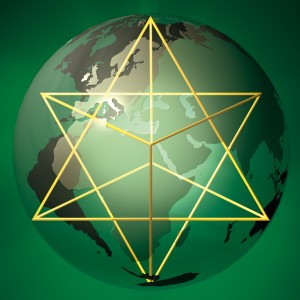Power Places
Now we have come full circle, arriving at the power places, most of which lie on the intersections of the ley lines that flow around the earth. The Lemurians and Atlanteans possessed this knowledge, as did the prehistoric advanced civilizations that followed them; they built their high-energy megalithic complexes, which they considered to be holy, in dimensions that are still inaccessible using unexplained construction methods. My studies, research, journey and spiritual vision indicate that there are 12 primary and 132 secondary power places, for a total of 144.
The profiles of the Power Places
Geosophy
This term refers to the holistic view of earth science that incorporates geomantic, energetic and spiritual areas as well as scientific information.
With an eye towards organizing the abundance of information about the 14 power places and facilitating geosophical comparison, I have used the following outline for each of the chapters:
1. Landscape
Geography
Geography describes the location of the power place on the globe and illustrates it on a map of the world.
It also includes information about the landscape and its topography.
Geology
This section defines the geological foundations of the region, its emergence and geodesic influences.
Climate
This section outlines the current climatic conditions and the annual weather cycle as well as those that existed at the times of any prehistoric advanced civilizations, if those conditions are known.
Vegetation
This section describes the local flora and the plant types that have taken hold in the region and characterize its landscape.
2. Power places
Names
The modern and the ancient names for the power places are listed and, to the extent possible, their meanings explained.
Geomancy
This is the view of the place, including the elements of the landscape and its energies.
Power place
The power points and their corresponding energies and chakras are listed here with relation to the earth body, colors and elements.
3. Structures
Main structures
This section lists all existing megalithic structures and the oldest existing structures from subsequent advanced civilizations.
Subterranean structures
This section describes the older core complexes that have usually been built over or expanded by later peoples.
Other structures in the region
This area is only included for power places with other existing megalithic structures in the region that have a direct connection to the builders or their time.
Temple structures
Here, the structures that can be shown to have been used as temples and places for the worship of the ancient gods are listed.
4. History
Historical History
In this section, the builders and cultures are placed in historical context as accepted by writers of history.
Finds
The archaeological finds that are linked to the builders, the age or the historical determination of the complex are listed here.
Prehistoric History
The section is generally based on ancient texts and legends and my own hypotheses and spiritual transmissions.
Builders and peoples
Here, the cultures that contributed to the construction of the complexes or influenced the history of the place are introduced.
Original purpose
Based on the identity of the builders, the actual purpose of the complex and the use for which each culture built or used it is described.
Legends and myths
The original purpose is complemented by legends and myths about these places and their builders, even if official academic history does not recognize them because they are not sufficiently verifiable.
5. Spirit
Religions and deities
A list of the names of the religions and cults with the names and characteristics of their deities follows.
Spirituality and transmissions
The religions are complemented by the spiritual view and the transmissions and viewpoints of beings that live in higher spheres.
Note:
As has already been mentioned in the section on the main power points, this list is not comprehensive; I have chosen them for GAIA Legacy because I have encountered them on my spiritual and physical journeys and they have been named and explained as the chakra points and often the ley points, even if their current location does not always correspond to the ley lines and intersections.
But, as in the deciphering of Giza and its legacy, my research here on GAIA and its power points remains ongoing; we are beginning to recognize these issue, but they have not yet adequately analyzed and documented. It may will be decades before their context and the energies can be documented and measured.
This is just a small excerpt from the book GAIA LEGACY.

